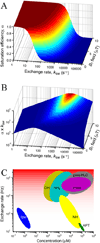Chemical exchange saturation transfer (CEST): what is in a name and what isn't?
- PMID: 21337419
- PMCID: PMC3148076
- DOI: 10.1002/mrm.22761
Chemical exchange saturation transfer (CEST): what is in a name and what isn't?
Abstract
Chemical exchange saturation transfer (CEST) imaging is a relatively new magnetic resonance imaging contrast approach in which exogenous or endogenous compounds containing either exchangeable protons or exchangeable molecules are selectively saturated and after transfer of this saturation, detected indirectly through the water signal with enhanced sensitivity. The focus of this review is on basic magnetic resonance principles underlying CEST and similarities to and differences with conventional magnetization transfer contrast. In CEST magnetic resonance imaging, transfer of magnetization is studied in mobile compounds instead of semisolids. Similar to magnetization transfer contrast, CEST has contributions of both chemical exchange and dipolar cross-relaxation, but the latter can often be neglected if exchange is fast. Contrary to magnetization transfer contrast, CEST imaging requires sufficiently slow exchange on the magnetic resonance time scale to allow selective irradiation of the protons of interest. As a consequence, magnetic labeling is not limited to radio-frequency saturation but can be expanded with slower frequency-selective approaches such as inversion, gradient dephasing and frequency labeling. The basic theory, design criteria, and experimental issues for exchange transfer imaging are discussed. A new classification for CEST agents based on exchange type is proposed. The potential of this young field is discussed, especially with respect to in vivo application and translation to humans.
Copyright © 2011 Wiley-Liss, Inc.
Figures














References
-
- Ward KM, Aletras AH, Balaban RS. A new class of contrast agents for MRI based on proton chemical exchange dependent saturation transfer (CEST) J Magn Reson. 2000;143:79–87. - PubMed
-
- Zhang S, Merritt M, Woessner DE, Lenkinski RE, Sherry AD. PARACEST agents: modulating MRI contrast via water proton exchange. Acc Chem Res. 2003:36783–36790. - PubMed
-
- Zhou J, van Zijl P. Chemical exchange saturation transfer imaging and spectroscopy. Prog Nucl Magn Reson Spectrosc. 2006;48:109–136. - PubMed
Publication types
MeSH terms
Substances
Grants and funding
LinkOut - more resources
Full Text Sources
Other Literature Sources
Medical
Research Materials

